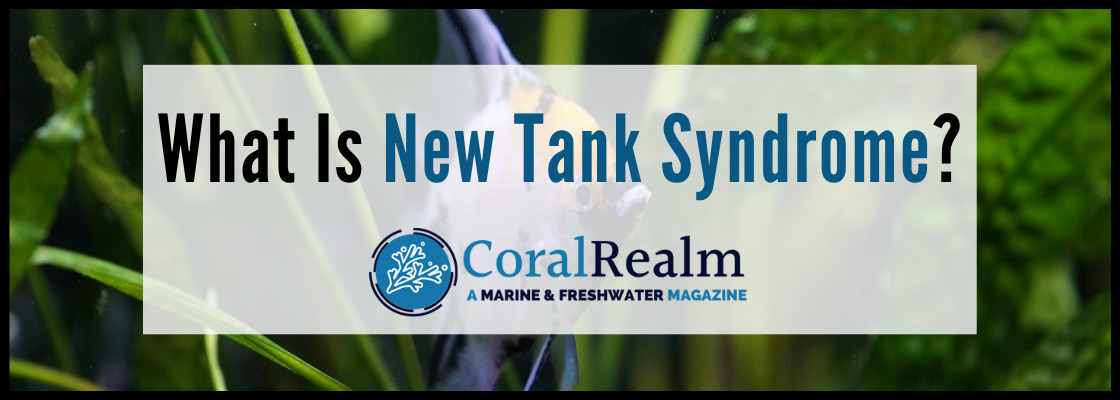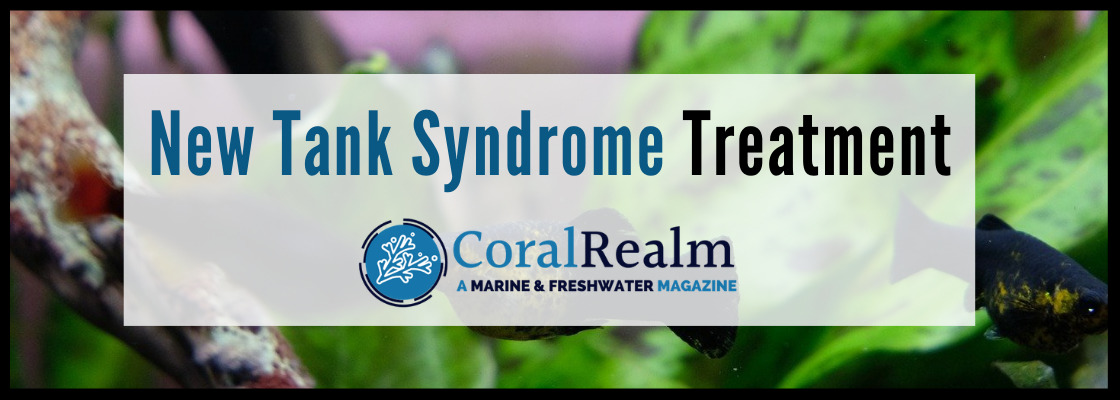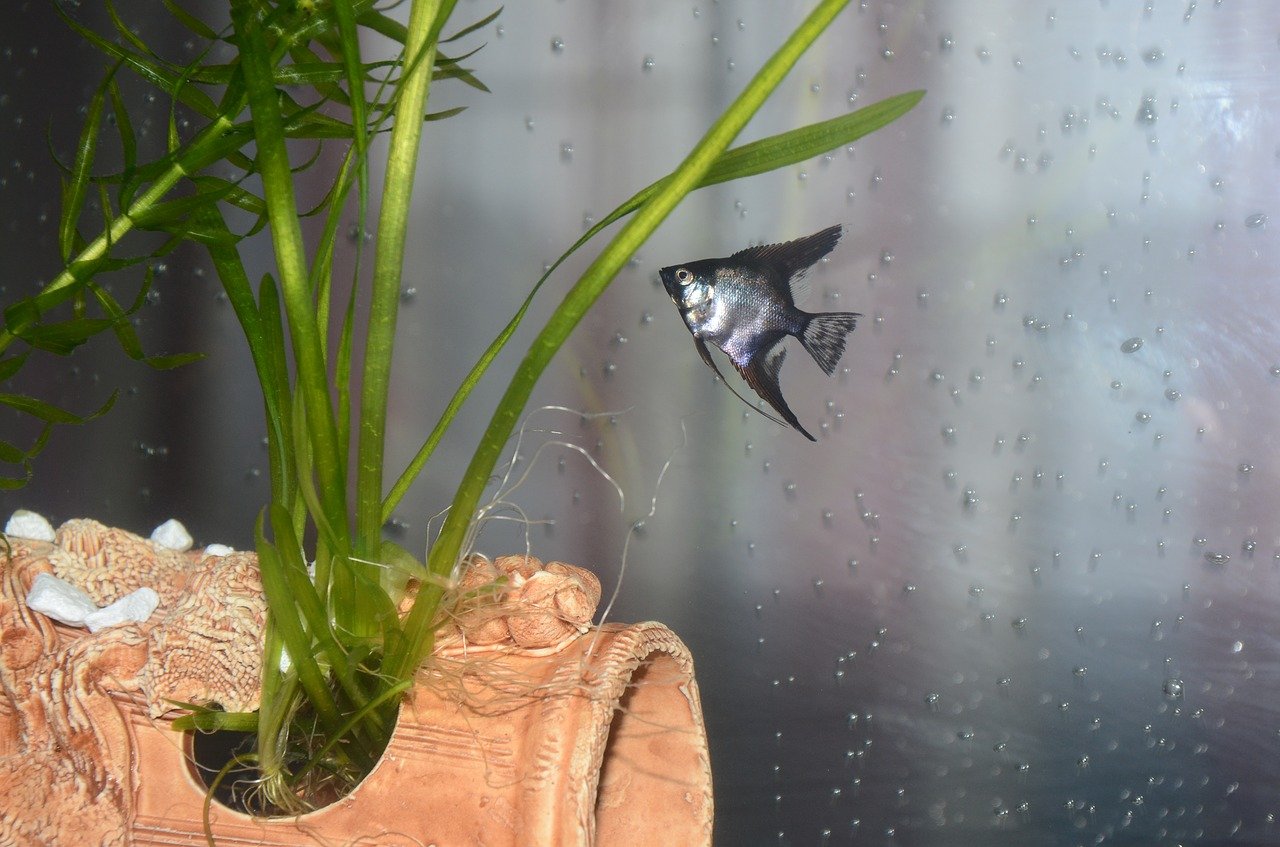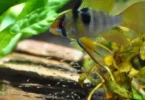Last Updated on February 10, 2023 by Matt
Poor water quality is the biggest and most common problem in fish tanks. New tank syndrome is so called because it mostly affects fish tanks that have just been set up. It can also be caused in mature tanks, which we will run through later in the article.
It is a feared occurrence in aquariums; it can quickly cause fish mortality. But what exactly is new tank syndrome, how do you fix it, and what can be done to prevent it?
IN THIS ARTICLE
What Is New Tank Syndrome?

During new tank syndrome the ammonia and nitrite levels in the tank rise rapidly to a very high level. Firstly the ammonia levels will rapidly rise, then will fall. During the fall in ammonia levels the nitrite levels will rapidly rise, before they too fall. New tank syndrome can also be called the “nitrite peak”, due to the very high nitrite levels that form.
This rapid rise in ammonia and nitrite concentration will lead to fish becoming extremely unwell, and will probably result in a high percentage of mortality.
Ammonia is incredibly toxic to fish and should be kept at 0 ppm in a tank to be healthy. Even at 0.05 ppm ammonia is incredibly toxic to fish, and causes ammonia poisoning. If ammonia concentration reaches 0.2 ppm you will have large scale fish death.
Nitrite levels in the tank also need to be 0 ppm to be healthy for fish and other animals. Even at levels up to 0.5 ppm you will need to take action about the build up of nitrite in the water column. At 5 ppm the level of nitrite is completely toxic and you will see major fish death. Even as low as 1 or 2 ppm the nitrite levels are critically dangerous to fish.
Causes Of New Tank Syndrome
New tank syndrome is caused by there being a lack of nitrifying bacteria in the aquarium.
You should read up on the aquarium nitrogen cycle for full information on how bacteria are a vital cog in the natural cycling of nitrogen through the tank.
We will give a brief overview here. As organic waste such as fish poo and excess food break down in the tank, ammonia is released. Ammonia is also released directly into the water column through fishes gills as a waste product. Nitrifying bacteria such as Nitrosomonas convert the ammonia into nitrite, and then other nitrifying bacteria such as Nitrobacter convert nitrite into nitrate. Denitrifying bacteria convert nitrate into atmospheric nitrogen.
So to the cause of new tank syndrome; it is most common in new fish tanks, hence the name, and we will explain that first.
In new tanks, new tank syndrome is caused by the initial lack of nitrifying bacteria. As there are no nitrifying bacteria present in the biological filtration media, no ammonia is converted to nitrite in the first step. So ammonia levels rise rapidly to incredibly dangerous levels. As Nitrosomonas bacteria colonize the filter they convert this ammonia to nitrite. As such, the ammonia concentration will fall and the nitrite levels will skyrocket. At this point, the high nitrite levels give the bacteria Nitrobacter the fuel it needs to colonize the filter. As the amount of bacteria grows it will use the nitrite and convert it to nitrate.
Nitrate is much less toxic than ammonia and nitrite, and can be tolerated to a much higher degree. As the tank finishes cycling, the levels of ammonia and nitrite will be undetectable, and the nitrate levels will be about 20 ppm in freshwater tanks.
So that is how new tank syndrome forms in new tanks. But it can’t form in an established tank which has already been cycled and has stable water chemistry can it?
New Tank Syndrome in an Older Mature Aquarium
Unfortunately, established older aquariums can still suffer from new tank syndrome. While old tank syndrome is more commonly seen, new tank syndrome is where there is a lack of nitrifying bacteria, and unfortunately there are a few conditions that can disrupt the bacterial colonies established in the biological filter.
A crash in bacterial numbers will mean that the aquarium is able to convert much less ammonia to nitrite, and nitrite to nitrate. As such the ammonia levels will rise rapidly until bacteria such as Nitrosomonas grow in numbers again. Nitrite levels will then rise rapidly until bacteria such as Nitrobacter increase in number.
We will run through some of these situations here.
After a big clean
A common cause of new tank syndrome in established tanks is a large scale clean all at the same time. We are talking about a deep clean of the substrate, the glass, the filter, and any decorations you may have.
While everything in the tank needs regular maintenance, doing it all at once can cause disruption to the bacteria that reside in the biological filter and in the substrate. Remember that nitrifying bacteria can be present on all surfaces in your tank, not only the filter and the substrate.
If you strip the tank down; remove the substrate and deep clean the filter, removing most of the water in the process, you can cause the bacterial colonies to crash. In the following days you will see the signs of new tank syndrome. If you test the water chemistry, you will see the spikes in ammonia and nitrite.
Using tap water to clean parts of the tank
This is a very common and basic error. Tap water contains contaminants and chemicals that are extremely toxic not only to the bacteria that are vital in removing ammonia and nitrite, but to your fish as well. These chemicals can include chlorine and heavy metals.
Using tap water to wash and clean your filter, or to rinse new or old decorations, or indeed any part of the tank will put these chemicals and compounds into the aquarium system.
Once in your tank these compounds will not only directly harm your fish but will also kill the beneficial bacterial colonies, whether they be in the biological filter media, the mechanical filtration media, or the substrate.
Once this bacteria is dead it will take time to get back to the level it was at. During this time of bacterial regrowth ammonia and nitrite levels will spike and new tank syndrome will hit.
Replacing all filter media at once
Replacing all the filtration media in one fell swoop is a common mistake to make. After all, if the media needs replacing then best to replace it right?
Actually, no. If you replace all of the media at once, you will take out all of the bacteria that have colonized that media. Nitrifying bacteria that remove ammonia and nitrite from the water column.
If you do this then the biological filter will crash, and new tank syndrome will hit as ammonia and nitrite levels run wild.
Not only will biological filter media house this bacteria, the mechanical filter media pads will as well. This is why it is recommended that only a maximum of a third of the media is replaced at once, and to simply gently clean the rest. If two thirds of the media remains, then enough of the bacterial colony will remain to quickly colonize the new media, and to still provide full biological filtration to your tank.
Symptoms of New Tank Syndrome
It can be very difficult to spot the onset of new tank syndrome, especially in well established tanks. This is because you cannot actually see the ammonia or nitrite concentrations rising. You need to rely on the behavior of the fish. But as the cause is ammonia and nitrite concentration spikes, the symptoms in your fish are the same, or very similar, as in ammonia and nitrite poisoning.
The following symptoms in your fish can be a sign that you have new tank syndrome. Whilst these symptoms can be a sign of other things, if you do see them it is time to test your water, and fast.
- Rapid gill movement
- Appetite loss
- Gasping for air at the surface or around filter outlet, air stones, or other sources of oxygenated water.
- Disorientation
- Curling in the body from head to tail
- Inflammation of the gills
- Browning of the gills
You can test your water using the following test kit:
- Contains one (1) API FRESHWATER MASTER TEST KIT 800-Test Freshwater Aquarium Water Master Test Kit, including 7 bottles of testing solutions, 1 color card and 4 tubes with cap
- Helps monitor water quality and prevent invisible water problems that can be harmful to fish and cause fish loss
- Accurately monitors 5 most vital water parameters levels in freshwater aquariums: pH, high range pH, ammonia, nitrite, nitrate
- Designed for use in freshwater aquariums only
- Use for weekly monitoring and when water or fish problems appear
This kit by API will allow you to test the ammonia and nitrite levels, but the pH as well, alongside nitrate and other conditions like general hardness and carbonate hardness.
Treatment

There are a few ways that you can go about treating new tank syndrome.
Firstly, have a set of aquarium testing kits at the ready, such as the API Freshwater Master Test Kit. This will allow you to see what the concentration of ammonia and nitrite is in the water and act accordingly. Remember that any level of ammonia or nitrite is a worry in an aquarium, and should be a great cause for concern.
If you have discovered that you have a spike in ammonia and nitrite, and think that your tank may have new tank syndrome, stop feeding your fish for at least a day. Ammonia is produced by decaying organic matter, so don’t fuel it with excess food. Only feed a very small minimal amount for the next few days. Your fish will be lethargic from the increased ammonia and nitrite levels, so only feed them the minimum and make sure it is eaten.
If you have caught the syndrome early, and only ammonia is spiking, then lowering the pH can help and have a beneficial impact. Lowering pH converts more dissolved ammonia (NH3) into ammonium (NH4+). It might seem a small change, but ammonium is much less toxic, and can be used by plants as a nitrogen source. This can help remove ammonia and stop its conversion to nitrite. Always be very careful though, as lowering pH rapidly can greatly stress fish further.
If lowering pH isn’t an option, then a large water change will be appropriate in ammonia spikes. Up to 50% can be done at a time. In the case of a nitrite level spike then small water changes of 5% every hour or so until you have changed 50% of the total water volume will be more appropriate. A sudden drop in nitrite levels can cause nitrite shock. Water changes can be made easier using a product like the Python water changer.
If you undertake any sort of water change, ensure that you use a proper water conditioner, such as Seachem Prime. If you are doing a large scale water change then you will also need to ensure that the water is the same temperature as the current aquarium water. If you suddenly lower or raise the temperature then you will greatly stress your fish.
Seachem Prime can also be used directly in the tank to remove ammonia and nitrite. It binds these nitrogenous compounds so that they can be removed by the filter. Other water conditioners can do a similar thing; just check that they can bind ammonia and nitrate, not all water conditioners can.
Prevention
Preventing new tank syndrome is the key. In new tanks which are being newly cycled, you cannot prevent it entirely as the nitrifying bacterial colonies haven’t established themselves yet. Therefore you need to be patient. It is strongly advised that you don’t put fish into the tank until it has finished cycling, a process called fishless aquarium cycling.
You can give the process a boost though; using an aquarium bacteria supplement can greatly speed up the fish tank cycling process.
These supplements introduce nitrifying and denitrifying bacteria into the water column where they colonize the biological filter media, and to a lesser extent the substrate and the mechanical filter media. API Quick Start and Seachem Stability are probably the most well-known and commonly used bacterial supplements, and we highly recommend them as well.
In established, older tanks, there are things you can do to prevent the onset of new tank syndrome.
You can ensure that the biological filter is fully functional. Ensure that you use highly porous media which provides an extremely high surface area for bacterial colonization. Porous media provides a much better site for colonization than plastic bio-balls for instance. Using bacteria supplements after filter cleanings will ensure that the bacteria colonies are well-maintained.
Speaking of aquarium filters, also ensure that the filter you are running is powerful enough for your tank; you want the capacity of the filter to encompass the size of your tank, and you want the flow rate to be at least three times the tank water volume. This way the water gets cycled and filtered minimum three times an hour.
You can also ensure that you clean and maintain the aquarium regularly. Using an aquarium vacuum cleaner to remove waste and debris from the substrate will prevent the buildup of organic waste which will release ammonia. Undertaking regular water changes will remove floating organic matter and will also directly remove any ammonia or nitrite build-up from the water column.
Overfeeding fish can cause new tank syndrome, as it increases the amount of decaying matter. Be careful how much you feed your fish, and only give as much as they can eat in a couple of minutes. Always keep an eye on how much your fish eat and how much they are wasting.
Overstocking is another contributing factor. Be mindful of how many fish you can keep in your tank. If you have a 10 gallon tank, you won’t be able to keep large fish species such as clown loaches or angelfish, or very many small fish. More fish equals more waste, equals more ammonia produced.
Conclusion
New tank syndrome is the spike in ammonia and nitrite levels that comes through a lack of nitrifying bacteria.
It can be very serious in mature tanks in which fish are present; both ammonia and nitrite are extremely toxic and will kill your fish in even small concentrations.
Fishless aquarium cycling is highly recommended for new tanks, so you don’t put fish through the stress of new tank syndrome.
There are things you can do to help prevent this phenomenon; using a good aquarium bacteria supplement after cleaning will reintroduce beneficial bacteria that are removed through the cleaning.









